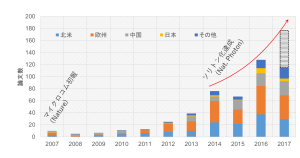
"Competence Revealed by the Numbers."
track record
- A research field attracting worldwide attention
The increase in the number of papers published worldwide (left figure) on optical frequency combs using micro optical resonators, our current primary focus, shows that the research field we are working on is hot right now.
Of course, this means that you will be exposed to fierce competition, but it also means that people all over the world find your work interesting and important. Only by winning and making friends can you continue to be involved in the hottest research that attracts the world's attention.

- research results
The following is the flow of undergraduate students after they are assigned to a laboratory. First, research is conducted in preparation for the thesis presentation in February. If the research progresses smoothly, additional experiments will be conducted before the conference of the Japan Society of Applied Physics (JSAP) in March. For many students, this will be their first formal presentation to the public. The questions and comments we receive from domestic professional researchers (university professors, corporate researchers, etc.) will clarify matters that we were not aware of. This is a natural progression that will lead to further improvement of our research, submission to international conferences, and publication of our work after the presentations at international conferences are over. This is not a story above the clouds; it is what you will be doing in a year's time.
The activities of our laboratory have attracted a great deal of attention both in Japan and abroad as we continue to publish many results. As a billboard, Professor Tanabe travels around the world, giving invited lectures at SPIE Photonics West, one of the world's largest international conferences. Students themselves present their cutting-edge results at international conferences. Professor Tanabe chairs top conferences such as AIP Advances published by the American Institute of Physics, Edia, a sister paper of Nature, and CLEO, and is in constant contact with the latest research results. By providing feedback to students on the hottest topics at these conferences, new seeds of research are continually being born.
Please refer to the Conference Presentations and Academic Papers pages for research results, respectively.
- TANABE LABORATORY in figures
H-index: 27
The h-index is one measure of a researcher's ability. The h-index is an aggregate value, so it tends to be higher for senior researchers, and it varies from field to field, but you can get a rough idea here. It can be seen that the h-index has attracted a great deal of attention, especially from overseas researchers. However, there are many more amazing researchers in Japan and abroad.
Doctoral advancement rate: 18.51 TP2T
The doctoral advancement rate is generally around 8%, so the rate is two to three times higher than that of other universities. This is because students feel that the research environment is excellent and that the content of research is promising. The low level of anxiety about future employment also contributes to the high rate. Students who have entered the doctoral program have received salaries from the Japan Society for the Promotion of Science (JSPS) and the Reading Graduate School, etc. In addition, the accuracy of RA in the laboratories has been enhanced, which has reduced their financial concerns while in school.
Percentage of Japanese PhDs employed by companies: 75%
The employment rate of Japanese PhDs who have graduated so far is 75% in companies, and the remaining 25% are in government offices. The market for electronics and photonics technology is large and closely related to industry, so there are many job openings, and there is no need to worry about finding a job. In addition, Professor Tanabe is well versed in the market for new graduates and mid-career hires, having served twice as an employment officer and as an advisor to a headhunting firm.
Percentage of graduate students presenting at international conferences : 100%
The calculation method is obtained by "Number of international conference presentations (student presentations only)/Number of graduate students" for the year 2019. Although the same student may have presented more than once, on average, a master's student will have one or two international conferences during his/her study. For the same reason, some years exceed 100%.
- What is Professor Tanabe's education?
- About Research at Tanabe Lab.
- Must see! Laboratory Introduction Video
- Dig Deeper TANABE Lab.
- You get a good idea of what the lab is like!
- Laboratory Information Session for FY2024 Assignees
We are holding a lab information session for students who will be assigned in 2024. Open Labs are free to come and go as they please. Individual information sessions are also available at any time.
.
- 10/23 (Mon) 16:30- Briefing Session 1 (Location: Bldg. 14, 2F DS43)
- 10/27 (Mon) 18:00- Explanatory Session 2 (Location: Bldg. 14, 2F DR8)
- 11/ 2 (Thu) 16:30- 3rd briefing (Location: 14th Bldg., 2F DR7)
- Laboratory tours and open labs (as needed)
Individual Information Sessions and Lab Tours













